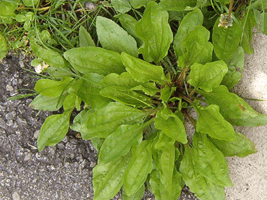 |
|||||
 |
 |
 |
 |
 |
 |
 |
Plant of the Month: Plantain |
||||
 With all the rain we’ve had in the past few weeks in the Montreal area the plantain leaves are bright green and succulent. Plantain grows abundantly in any open sunny spaces, especially along paths, driveways or fields. I’ve even seen it growing right through the asphalt in city parks! The Natives considered plantain one of their sacred herbs and referred to it as “White man’s foot” because it spread so quickly with the arrival of early explorers.  This plant was first introduced to me as Nature’s Band-Aid and over the years it has held true to its moniker. It works wonders on burns, cuts, insect bites, wasp and stinging nettle stings or poison ivy and is an effective remedy when a fall results in a scraped knee or elbow, away from the first-aid kit. Simply find a patch of plantain, select a few clean, whole, bright green leaves and roughly chew them to make a “spit-poultice”. The taste is a very green, grass flavour but not unpleasant. Even my boys as children would make their own spit poultice to treat an injury. {If you have a kitchen nearby you could also do this with a mortar and pestle, or food processor, or even apply lightly steamed, cooled plantain leaf to the affected area}.   Both Plantago major, with its broad, round-ish leaves and Plantago lanceolata, with its long, thin leaves can be used for medicinal purposes. They can be identified by their prominent ribs (usually five) located on the back of each leaf. Each plant sends leaves out from one base point and usually grows to about the size of your outstretched hand. When they go to seed later in the season, wait for the seeds to turn brown and harvest them on a dry day. Add a handful of pre-soaked seeds to your grains (rice, oats, millet, etc.) and cook them together to get an extra dose of fiber which is often lacking in the average North American diet. Besides fiber’s well-known ability to support the digestive system (check the label of the anti-constipating remedy Metamucil and notice that plantago is the main ingredient), fiber also promotes heart health by significantly lowering cholesterol levels.  Another simple way to prepare Plantain is to infuse it in olive oil for a four to six weeks and then harden it with beeswax (available from any beekeeper, often at your local market) to make a salve {For more info on Herbal Preparations click on the Herbal Health root on the toolbar at the top of the page.} The salve works wonders on itchy bug bites, hives or rashes. The young leaves are also edible and can be added to your salad before they get too tough, but beware of their laxative effect! Older leaves can be dried for use in infusions that nourish the urinary system and soothe respiratory problems. This cheery, plentiful weed should be identified by everyone in your family for a useful remedy the next time someone needs a quick fix. | |||||
 | |||||
|
Over the years I have been blessed with many inspirational teachers. I thank them for sharing their wisdom through their lectures, workshops, websites and books. For more information about plantain and many other herbs, enjoy these insightful and informative resources. | |||||
|
Opening our Wild Hearts to the Healing Herbs by Gail Faith Edwards |
(Ash Tree Publishing, 2000) Click for website (Storey Books, 2001) Click for website (Ash Tree Publishing, 1997) (Pocket Books, 1998) Click for website |
||||

|
|||||
 ©2026 Monica Giacomin ©2026 Monica Giacomin |
|||||